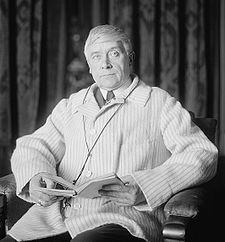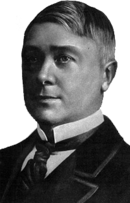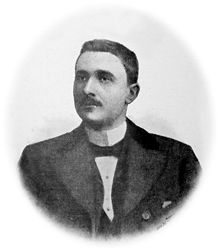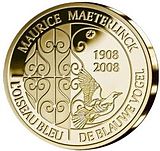- Maurice Maeterlinck
-
Maurice Maeterlinck 
Born Maurice Polydore Marie Bernard
29 August 1862
Ghent, BelgiumDied 6 May 1949 (aged 86)
Nice, FranceOccupation Playwright · Poet · Essayist Language French Nationality Belgian Literary movement Symbolism Notable work(s) Intruder (1890)
The Blind (1890)
Interior (1895)
The Blue Bird (1908)Notable award(s) Nobel Prize in Literature
1911
Triennial Prize for Dramatic Literature
1903Spouse(s) Renée Dahon Partner(s) Georgette Leblanc
InfluencedMaurice Polydore Marie Bernard Maeterlinck,[1] also called Comte (Count) Maeterlinck from 1932,[2] (French pronunciation: [mo.ʁis ma.tɛʁ.lɛ̃ːk] in Belgium, mɛ.teʁ.lɛ̃ːk in France;[3] 29 August 1862 – 6 May 1949) was a Belgian playwright, poet, and essayist who wrote in French. He was awarded the Nobel Prize in Literature in 1911. The main themes in his work are death and the meaning of life. His plays form an important part of the Symbolist movement.
Contents
Biography
Early life
Maeterlinck was born in Ghent, Belgium to a wealthy, French-speaking family. His father, Polydore, was a notary who enjoyed tending the greenhouses on their property. His mother, Mathilde, came from a wealthy family.[4]
In September 1874 he was sent to the Jesuit College of Sainte-Barbe, where works of the French Romantics were scorned and only plays on religious subjects were permitted. His experiences at this school influenced his distaste for the Catholic Church and organized religion.[5]
He had written poems and short novels during his studies, but his father wanted him to go into law. After finishing his law studies at the University of Ghent in 1885, he spent a few months in Paris, France. He met some members of the new Symbolism movement, Villiers de l'Isle Adam in particular, who would have a great influence on Maeterlinck's subsequent work.
Career
Maeterlinck instantly became a public figure when his first play, Princess Maleine, received enthusiastic praise from Octave Mirbeau, the literary critic of Le Figaro in August 1890. In the following years, he wrote a series of symbolist plays characterized by fatalism and mysticism, most importantly Intruder (1890), The Blind (1890) and Pelléas and Mélisande (1892).
He had a relationship with the singer and actress Georgette Leblanc from 1895 till 1918. Leblanc influenced his work for the following two decades. With the play Aglavaine and Sélysette Maeterlinck began to create characters, especially female characters, more in control of their destinies. Leblanc performed these female characters on stage. Even though mysticism and metaphysics influenced his work throughout his career, he slowly replaced his Symbolism with a more existential style.[6]
In 1895, with his parents frowning upon his open relationship with an actress, Maeterlinck and Leblanc moved to the district of Passy in Paris. The Catholic Church was unwilling to grant her a divorce from her Spanish husband. They frequently entertained guests, including Mirbeau, Jean Lorrain, and Paul Fort. They spent their summers in Normandy. During this period, Maeterlinck published his Twelve Songs (1896), The Treasure of the Humble (1896), The Life of the Bee (1901), and Ariadne and Bluebeard (1902).[6]
In 1903, Maeterlinck received the Triennial Prize for Dramatic Literature from the Belgian government.[7]
In 1906, Maeterlinck and Leblanc moved to a villa in Grasse. He spent his hours meditating and walking. As he emotionally pulled away from Leblanc, he entered a state of depression. Diagnosed with neurasthenia, he rented the Benedictine Abbey of St. Wandrille in Normandy to help him relax. Leblanc would often walk around in the dress of an abbess; he would wear roller skates as he moved about the house.[8] During this time, he wrote his essay "The Intelligence of Flowers" (1906), in which he discussed politics and championed socialist ideas. He donated money to many workers' unions and socialist groups. At this time he conceived his greatest contemporary success: the fairy play The Blue Bird (1908). He also wrote Marie-Victoire (1907) and Mary Magdalene (1910) with lead roles for Leblanc.[9] With the exception of The Blue Bird, critics did not praise these plays and considered Leblanc no longer an inspiration to the playwright. Even though alfresco performances of some of his plays at St. Wandrille had been successful, Maeterlinck felt that he was losing his privacy. The death of his mother on 11 June 1910 added to his depression.[10]
In 1910 he met the 18-year-old actress Renée Dahon during a rehearsal of The Blue Bird. She became his lighthearted companion. Winning the Nobel Prize for Literature served to heighten his spirits, as well. By 1913, he was more openly socialist and sided with the Belgian trade unions against the Catholic party during a strike.[11] He began to study mysticism and lambasted the Catholic Church in his essays for misconstruing the history of the universe.[12] By a decree of 26 January 1914, his opera omnia were placed on the Index Librorum Prohibitorum by the Roman Catholic Church.
When Germany invaded Belgium in 1914, Maeterlink wished to join the French Foreign Legion, but his application was denied due to his age. He and Leblanc decided to leave Grasse for a villa near Nice, where he spent the next decade of his life. He gave speeches on the bravery of the Belgian people and placed guilt upon all Germans for the war. While in Nice he wrote The Mayor of Stilmonde, which was quickly labeled by the American press as a "Great War Play." He also wrote The Betrothal, a sequel to The Blue Bird, in which the heroine of the play is clearly not a Leblanc archetype.[13]
On 15 February 1919 Maeterlinck married Dahon. He accepted an invitation to the United States. Samuel Goldwyn asked him to produce a few scenarios for film. Only two of Maeterlinck's submissions still exist; Goldwyn didn't use any of them. Maeterlinck had prepared one based on his The Life of the Bee. After reading the first few pages Goldwyn burst out of his office, exclaiming: "My God! The hero is a bee!"
By the 1920s, Maeterlinck found himself no longer in tune with the times. His plays of this period (The Power of the Dead, The Great Secret, Berniquel) received little attention. Dahon gave birth to a stillborn child in 1925.
Plagiarism
In 1926 Maeterlinck published La Vie des Termites (translated into English as The Life of the Termite or The Life of the White Ant), an entomological book that plagiarised the book The Soul of the (White) Ant, researched and written by the Afrikaner poet and scientist Eugene Marais,[14] in what has been called "a classic example of academic plagiarism" by University of London's professor of biology, David Bignell.[15]
Marais accused Maeterlinck of having used his concept of the "organic unity" of the termitary in his book.[16] Marais had published his ideas on the termitary in the South African Afrikaans-language press, both in Die Burger in January 1923 and in Huisgenoot, which featured a series of articles on termites under the title "Die Siel van die Mier" (The Soul of the (White) Ant) from 1925 to 1926. Maeterlinck's book, with almost identical content,[15] was published in 1926. Maeterlinck was able to commit the plagiarism because he was Belgian and, though his mother tongue was French, he was fluent in Dutch, from which Afrikaans was derived. It was common at the time for worthy articles published in Afrikaans to be reproduced in Flemish and Dutch magazines and journals.
Supported by a coterie of Afrikaner Nationalist friends, Marais sought justice through the South African press and attempted an international lawsuit. This was to prove financially impossible and the case was not pursued. However, Marais gained a measure of renown as the aggrieved party and as an Afrikaner researcher who had opened himself up to plagiarism because he published in Afrikaans out of nationalistic loyalty. Marais brooded at the time of the scandal: "I wonder whether Maeterlinck blushes when he reads such things [critical acclaim], and whether he gives a thought to the injustice he does to the unknown Boer worker?"[16]
Maeterlinck's own words in The Life of the Termite indicate that the possible discovery or accusation of plagiarism worried him:
It would have been easy, in regard to every statement, to allow the text to bristle with footnotes and references. In some chapters there is not a sentence but would have clamoured for these; and the letterpress would have been swallowed up by vast masses of comment, like one of those dreadful books we hated so much at school. There is a short bibliography at the end of the volume which will no doubt serve the same purpose.
Despite these misgivings, there is no reference to Eugene Marais in the bibliography. Maeterlinck's other works on entomology include The Glass Spider (1923) and The Life of the Ant (1930).
Robert Ardrey, an admirer of Eugene Marais's, attributed Marais's later suicide to this act of plagiarism and theft of intellectual property by Maeterlinck,[17] although Marais' biographer, Leon Rousseau, speculated that Marais enjoyed and thrived on the controversy and attention generated by the controversy.[18]
Later life
In 1930 he bought a château in Nice, France, and named it Orlamonde, a name occurring in his work Quinze Chansons.
He was made a count by Albert I, King of the Belgians in 1932.
According to an article published in the New York Times in 1940, he arrived in the United States from Lisbon on the Greek Liner Nea Hellas. He had fled to Lisbon in order to escape the Nazi invasion of both Belgium and France. The Times quoted him as saying, "I knew that if I was captured by the Germans I would be shot at once, since I have always been counted as an enemy of Germany because of my play, The Mayor of Stilmonde, which dealt with the conditions in Belgium during the German Occupation of 1918." As with his earlier visit to America, he still found Americans too casual, friendly and Francophilic for his taste.[19]
He returned to Nice after the war on 10 August 1947. In 1948, the French Academy awarded him the Medal for the French Language. He died in Nice on 6 May 1949 after suffering a heart attack. There was no priest at his funeral.
Static drama
Maeterlinck, an avid reader of Arthur Schopenhauer, considered man powerless against the forces of fate. He believed that any actor, due to the hindrance of physical mannerisms and expressions, would inadequately portray the symbolic figures of his plays. He concluded that marionettes were an excellent alternative. Guided by strings operated by a puppeteer, Maeterlinck considered marionettes an excellent representation of fate's complete control over man. He wrote Interior, The Death of Tintagiles, and Alladine and Palomides for marionette theatre.[20]
From this, he gradually developed his notion of the "static drama." He felt that it was the artist's responsibility to create something that did not express human emotions but rather the external forces that compel people.[21] Materlinck once wrote that "the stage is a place where works of art are extinguished. [...] Poems die when living people get into them."[22]
He explained his ideas on the static drama in his essay "The Tragic in Daily Life" (1896), which appeared in The Treasure of the Humble. The actors were to speak and move as if pushed and pulled by an external force, fate as puppeteer. They were not to allow the stress of their inner emotions to compel their movements. Maeterlinck would often continue to refer to his cast of characters as "marionettes."[23]
Maeterlinck's conception of modern tragedy rejects the intrigue and vivid external action of traditional drama in favour of a dramatisation of different aspects of life:
“ Othello is admirably jealous. But is it not perhaps an ancient error to imagine that it is at the moments when this passion, or others of equal violence, possesses us, that we live our truest lives? I have grown to believe that an old man, seated in his armchair, waiting patiently, with his lamp beside him; giving unconscious ear to all the eternal laws that reign about his house, interpreting, without comprehending, the silence of doors and windows and the quivering voice of the light, submitting with bent head to the presence of his soul and his destiny—an old man, who conceives not that all the powers of this world, like so many heedful servants, are mingling and keeping vigil in his room, who suspects not that the very sun itself is supporting in space the little table against which he leans, or that every star in heaven and every fiber of the soul are directly concerned in the movement of an eyelid that closes, or a thought that springs to birth—I have grown to believe that he, motionless as he is, does yet live in reality a deeper, more human, and more universal life than the lover who strangles his mistress, the captain who conquers in battle, or "the husband who avenges his honor."[24] ” He cites a number of classical Athenian tragedies—which, he argues, are almost motionless and which diminish psychological action to pursue an interest in "the individual, face to face with the universe"—as precedents for his conception of static drama; these include most of the works of Aeschylus and Sophocles' Ajax, Antigone, Oedipus at Colonus, and Philoctetes.[25] With these plays, he claims:
“ It is no longer a violent, exceptional moment of life that passes before our eyes—it is life itself. Thousands and thousands of laws there are, mightier and more venerable than those of passion; but these laws are silent, and discreet, and slow-moving; and hence it is only in the twilight that they can be seen and heard, in the meditation that comes to us at the tranquil moments of life.[26] ” Maeterlinck in music
Pelléas and Mélisande inspired four major musical compositions at the turn of the 20th century:
- 1898: an orchestral suite (sometimes described as incidental music) by Gabriel Fauré (Op. 80)
- 1893-1902: an opera by Claude Debussy (L. 88, Paris) - see Pelléas et Mélisande (opera)
- 1902-1903: a symphonic poem by Arnold Schoenberg (Op. 5)
- 1905: incidental music by Jean Sibelius (Op. 46) - see Pelléas et Mélisande (Sibelius).
Other musical works based on Maeterlinck's plays include:
- Aglavaine and Sélysette
- orchestral prelude by Arthur Honegger
- Aladina and Palomid
- opera by Burghauser
- opera by Osvald Chlubna
- opera by Emil František Burian
- Ariane et Barbe-bleue
- opera in 3 acts by Paul Dukas
- incidental music by Anatoly Nikolayevich Alexandrov
- The Betrothal
- incidental music by Armstrong Gibbs
- The Blind
- opera by Beat Furrer
- opera Slepcy by Polish composer Jan Astriab after Maeterlinck's Les aveugles
- The Death of Tintagiles
- symphonic poem by Charles Martin Loeffler
- incidental music by Ralph Vaughan Williams
- opera by Lawrance Collingwood
- overture by Carse
- opera by Nougues
- symphonioc poem by Santoliquido
- orchestral prelude by Voormolen
- Monna Vanna
- opera in 3 acts by Emil Ábrányi
- Monna Vanna, opera in 4 acts by Henry Février
- Monna Vanna - an unfinished opera by Sergei Rachmaninoff
- opera in 4 acts by Nicolae Brânzeu
- L'oiseau bleu
- opera by Albert Wolff
- 13 scenes for orchestra by Fritz Hart
- incidental music by Leslie Heward
- incidental music by Engelbert Humperdinck
- overture by Kricka
- incidental music by Norman O'Neill
- incidental music by Szeligowski
- Princess Maleine
- overture by Pierre de Bréville
- overture by Cyril Scott
- unfinished opera (or incidental music) by Lili Boulanger
- incidental music by Maximilian Steinberg
- The Seven Princesses
- incidental music by Bréville
- opera by Nechayev
- Soeur Beatrice
- opera by Alexander Grechaninov
- chorus by Anatoly Liadov
- opera Sor Beatriz by Marquez Puig
- opera by Dmitri Mitropoulos
- opera by Rasse
Works
Poetry
- Serres chaudes (1889)
- Douze chansons (1896)
- Quinze chansons (expanded version of Douze chansons) (1900)
Drama
- La Princesse Maleine (Princess Maleine) (published 1889)
- L'Intruse (Intruder) (published 1890; first performed 21 May 1891)
- Les Aveugles (The Blind) (published 1890; first performed 7 December 1891)
- Les Sept Princesses (The Seven Princesses) (published 1891)
- Pelléas and Mélisande (published 1892; first performed 17 May 1893)
- Alladine et Palomides (published 1894)
- Intérieur (Interior) (published 1894; first performed 15 March 1895)
- La Mort de Tintagiles (The Death of Tintagiles) (published 1894)
- Aglavaine et Sélysette (first performed December 1896)
- Ariane et Barbe-bleue (Ariane and Bluebeard) (first published in German translation, 1899)
- Soeur Béatrice (Sister Beatrice) (published 1901)
- Monna Vanna (first performed May 1902; published the same year)
- Joyzelle (first performed 20 May 1903; published the same year)
- Le Miracle de saint Antoine (The Miracle of Saint Antony) (first performed in German translation, 1904)
- L'Oiseau bleu (The Blue Bird) (first performed 30 September 1909)
- Marie-Magdeleine (Mary Magdalene) (first performed in German translation, February 1910; staged and published in French, 1913)
- Le Bourgmestre de Stilmonde (first performed in Buenos Aires, 1918; published 1919)
- Les Fiançailles (published 1922)
- Le Malheur passe (published 1925)
- La Puissance des morts (published 1926)
- Berniquel (published 1926)
- Marie-Victoire (published 1927)
- Judas de Kerioth (published 1929)
- La Princess Isabelle (published 1935)
- L'Autre Monde ou le cadran stellaire (The Other World, or The Star System) (1941)
- Jeanne d'Arc (Joan of Arc) (published 1943)
Essays
- Le Trésor des humbles (The Treasure of the Humble) (1896)
- La sagesse et la destinée (Wisdom and Destiny) (1898)
- La Vie des abeilles (The Life of the Bee) (1901)
- Le temple enseveli (The Buried Temple) (1902)
- Le Double Jardin (The Double Garden) (1904)
- L'Intelligence des fleurs (The Intelligence of Flowers) (1907)
- L'Hôte inconnu (first published in English translation, 1914; in original French, 1917)
- Les Débris de la guerre (1916)
- La Vie des termites (The Life of the Termite) (1926)
- La Vie de l'espace (The Life of Space) (1928)
- La Grande Féerie (1929)
- La Vie des fourmis (The Life of the Ant) (1930)
- L'Araignée de verre (1932)
- Avant la grande silence (Before the Great Silence) (1934)
- L'Ombre des ailes (The Shadow of Wings) (1936)
- Devant Dieu (1937)
Memoirs
- Bulles bleues (1948)
Translations
- Le Livre des XII béguines and L'Ornement des noces spirituelles, translated from the Flemish of Ruysbroeck (1885)
- L'Ornement des noces spirituelles de Ruysbroeck l'admirable (1891)
- Annabella, an adaptation of John Ford's 'Tis Pity She's a Whore (performed 1894)
- Les Disciples à Saïs and Fragments de Novalis from the German of Novalis, together with an Introduction by Maeterlinck on Novalis and German Romanticism (1895)
- Translation and adaptation of Shakespeare's Macbeth (performed 1909)
See also
- The 100th anniversary of Maurice Maeterlinck's greatest contemporary success, his play The Blue Bird, was selected as the main motif of a high-value collectors' coin: the Belgian 50 euro Maurice Maeterlinck commemorative coin, minted in 2008.
- Belgian literature
References
- ^ Spelled Maurice (Mooris) Polidore Marie Bernhard Maeterlinck on the official Nobel Prize page
- ^ Maeterlinck, Maurice in Encyclopædia Britannica
- ^ Jean-Marie Pierret, Phonétique historique du français et notions de phonétique générale, 1994
- ^ Bettina Knapp, Maurice Maeterlinck, (Thackery Publishers: Boston, 1975), 18.
- ^ Knapp, 22-3.
- ^ a b Knapp, 87-92.
- ^ Knapp, 111.
- ^ Knapp, 129.
- ^ Knapp, 127-8.
- ^ Knapp, 133-4.
- ^ Knapp, 133-6.
- ^ Knapp, 136-8.
- ^ Knapp, 147-50.
- ^ "Die Huisgenoot", Nasionale Pers, 6 January 1928, cover story.
- ^ a b Professor David E. Bignell. "Termites: 3000 Variations On A Single Theme". http://www.biology.qmul.ac.uk/research/staff/bignell/Inaugural.htm. Retrieved 2009-07-28.
- ^ a b Sandra Swart (2004). "The Construction of Eugène Marais as an Afrikaner Hero". Journal of Southern African Studies. 30.4, December (30.4). http://www.oulitnet.co.za/seminarroom/marais_swart.asp.
- ^ Robert Ardrey,The Territorial Imperative: A Personal Inquiry into the Animal Origins of Property and Nations (1966)
- ^ Leon Rousseau, The Dark Stream, (Jonathan Ball Publishers:Cape Town, 1982)
- ^ Knapp, 157-8.
- ^ Knapp, 77-78.
- ^ Knapp, 78.
- ^ "Drama---Static and Anarchistic," New York Times, Dec. 27, 1903.
- ^ Peter Laki, Bartók and His World, (Princeton University Press, 1995), 130-131.
- ^ Cole (1960, 30-31).
- ^ Cole (1960, 31-32).
- ^ Cole (1960, 32).
Further reading
- W. L. Courtney, The Development of M. Maeterlinck (London, 1904)
- M. J. Moses, Maurice Maeterlinck: A Study (New York, 1911)
- E. Thomas, Maurice Maeterlinck, (New York, 1911)
- J. Bethell, The life and Works of Maurice Maeterlinck (New York, 1913)
- Archibald Henderson, European Dramatists (Cincinnati, 1913)
- E. E. Slosson, Major Prophets of To-Day (Boston, 1914)
- G. F. Sturgis, The Psychology of Maeterlinck as Shown in his Dramas (Boston, 1914)
- P. McGuinness, "Maeterlinck and the making of Modern Theatre" (Oxford, 2000)
External links
- The Social Significance of Modern Drama; Monna Vanna, Analysis of the play by Maurice Maeterlinck
- Works by Maurice Maeterlinck at Project Gutenberg
- List of works by Maurice Maeterlinck at the Online Books Page
- a transcript of the Nobel prize presentation speech
- Video clips from four different productions of Maeterlinck's works
The works of Maurice Maeterlinck Plays Princess Maleine • Intruder • The Blind • The Seven Princesses • Pelléas and Mélisande • Alladine and Palomides • Interior • The Death of Tintagiles • Aglavaine and Sélysette • Ariane and Bluebeard • Sister Beatrice • Monna Vanna • Joyzelle • The Blue Bird • Mary Magdelene • The Miracle of St. Anthony • The Mayor of Stilmonde • The Betrothal • The Cloud That Lifted • The Power of the Dead • Berniquel • Marie-Victoire • Joan of Arc • Father Setubal • The Three Justiciaries • The Last Judgment
Poems Hothouses • Twelve SongsShort stories The Massacre of the Innocents • OnirologyBallet The Dance of the StarsEssays & prose The Treasure of the Humble • Wisdom and Destiny • The Life of the Bee • The Intelligence of Flowers • The Life of the Termite • Blue BubblesNobel Laureates in Literature (1901–1925) - Sully Prudhomme (1901)
- Theodor Mommsen (1902)
- Bjørnstjerne Bjørnson (1903)
- Frédéric Mistral / José Echegaray (1904)
- Henryk Sienkiewicz (1905)
- Giosuè Carducci (1906)
- Rudyard Kipling (1907)
- Rudolf Eucken (1908)
- Selma Lagerlöf (1909)
- Paul Heyse (1910)
- Maurice Maeterlinck (1911)
- Gerhart Hauptmann (1912)
- Rabindranath Tagore (1913)
- Romain Rolland (1915)
- Verner von Heidenstam (1916)
- Karl Gjellerup / Henrik Pontoppidan (1917)
- Carl Spitteler (1919)
- Knut Hamsun (1920)
- Anatole France (1921)
- Jacinto Benavente (1922)
- William Butler Yeats (1923)
- Władysław Reymont (1924)
- George Bernard Shaw (1925)
- Complete list
- (1901–1925)
- (1926–1950)
- (1951–1975)
- (1976–2000)
- (2001–2025)
Categories:- 1862 births
- 1949 deaths
- Belgian dramatists and playwrights
- Belgian Nobel laureates
- Belgian poets in French
- Belgian writers in French
- Counts of Belgium
- French essayists
- French fantasy writers
- French-language poets
- Ghent University alumni
- Modernist drama, theatre and performance
- Nobel laureates in Literature
- People from Ghent
- Plagiarism controversies
- Plagiarism
- Symbolist dramatists and playwrights
- Works by Maurice Maeterlinck
Wikimedia Foundation. 2010.



